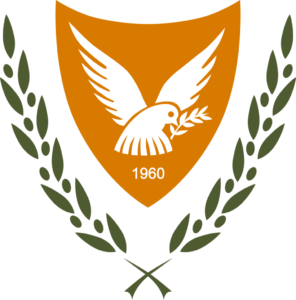About Cyprus
National Day: 1st October
Independence Day: 1st October 1960
Government: Republic with a presidential system
Current Government as of 1 March 2023 (for a five year term):
President of the Republic of Cyprus: H.E. Nikos Christodoulides
For the composition of the current Council of Ministers click here
Official Languages: Greek, Turkish
Capital: Lefkosia (Nicosia)
The Emblem of the Republic of Cyprus:
Location: Situated at the north-eastern end of the Mediterranean basin, Cyprus is the third largest island in the region, with an area of 9,251 square kilometres (3,572 square miles). The latitude of Cyprus is 34° 33’-35° 34’ North, and its longitude is 32° 16’-34° 37’ East.
Climate: Mediterranean climate; hot, dry summers and mild winters.
-
-
The weather in Cyprus today
-
Demography:
Total population in the Republic of Cyprus: 918.000 (October 2021)
– Greek Cypriots (690.900)
– Turkish Cypriots (1,128 in 2011)
– Foreign residents (193.300)
Population distribution per district
In 2021 the population of the island’s main towns is as follows:
– Lefkosia (Nicosia): 351.600 (part of Lefkosia in the Government controlled area)
– Lemesos (Limassol): 258.900
– Larnaka (Larnaca): 154.200
– Pafos (Paphos): 101.900
– Ammochostos (Free Famagusta) rural area: 51.500
Natural resources: Copper, pyrites, asbestos, gypsum, timber, salt, marble, clay earth pigment.
Economy: Services oriented market economy (approx. 80% of GDP).
Sectors: Services (tourism, financial services, real estate, telecommunications), Industry (cement and gypsum production, textiles, light chemicals, metal products, wood, paper, stone and clay products), Agriculture and Fisheries (citrus, vegetables, barley, grapes, olives).
Per Capita GDP: €27.777 (2022 estimate)
Unemployment rate: 5,9% (2nd quarter 2023)
Inflation rate: 4% (September 2023)
Exports: €414,3 million (August 2023)
Imports: €1.083,6 million (August 2023)
For more data regarding the economy, employment, external trade, exports and imports, Industry, Services, Science and Technolody visit the Cyprus Statistical Service
Brief Historical Survey
| DATE | PERIOD |
| 10th millenium | Akrotiri-Aetokremmos |
| 9th millenium – 5200 B.C. | Aceramic Neolithic |
| 5000 – 3900 B.C. | Ceramic Neolithic |
| 3900 – 2500 B.C. | Chalcolithic |
| 2500 – 1900 B.C. | Early Bronze Age |
| 1900 – 1600 B.C. | Middle Bronze Age |
| 1600 – 1050 B.C. | Late Bronze Age |
| 1050 – 750 B.C. | Geometric |
| 750 – 480 B.C. | Archaic |
| 480 – 310 B.C. | Classical |
| 310 B.C – 30 B.C | Hellenistic |
| 30 B.C. – 330 A.D. | Roman |
| 330 – mid 7th century A.D. | Early Christian |
| mid 7th century – 965 A.D. | Byzantine – Arab raids |
| 965 – 1191 A.D. | Byzantine |
| 1191 – 1489 A.D. | Frankish |
| 1489 – 1571 A.D. | Venetian |
| 1571 – 1878 A.D. | Ottoman |
| 1878 – 1960 A.D. | British |
| 1960 | Independence of the Republic of Cyprus/ Accession to the United Nations Organisation |
| 1974 | Turkish Invasion |
| 2004 | Accession to the European Union (EU) |
| 2008 | Adoption of the Euro |

